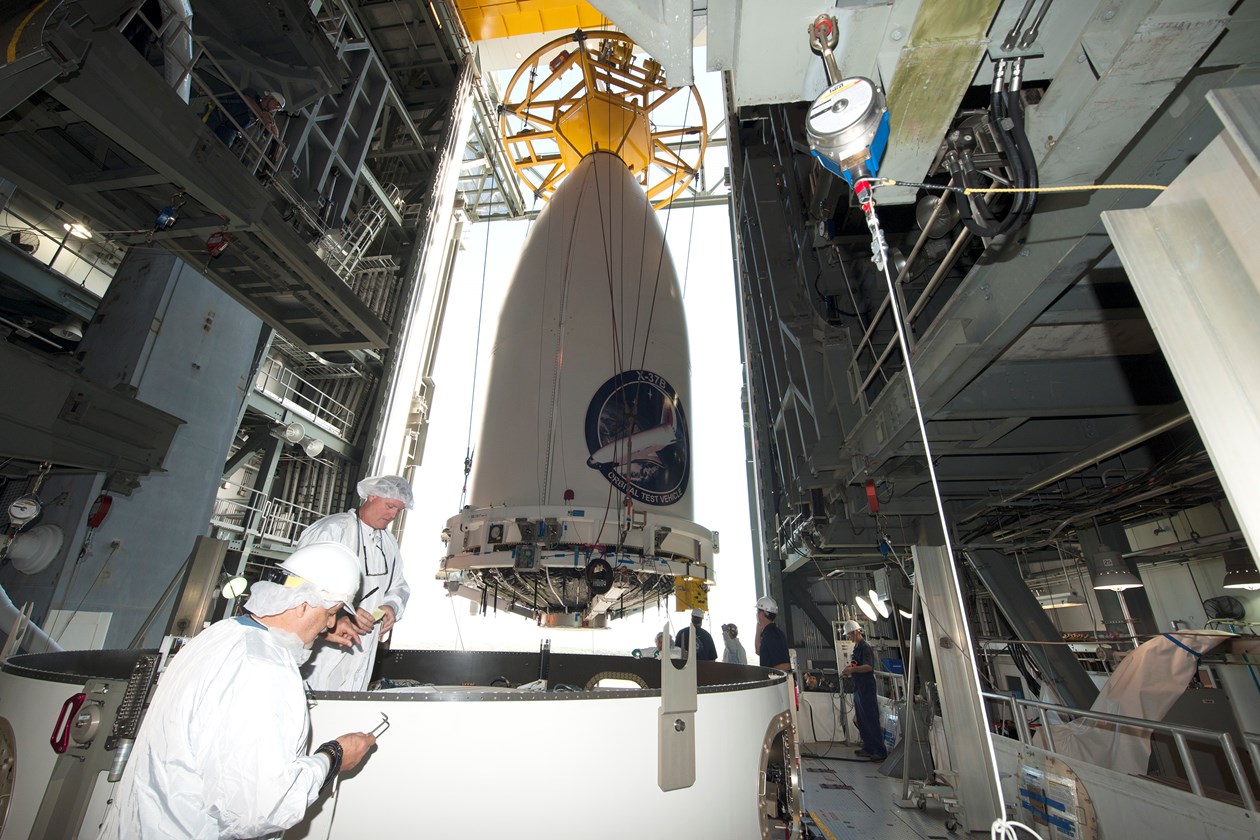
The rocket tasked with launching the next mission from Cape Canaveral, Fla., is well into its final processing events for a scheduled launch attempt on May 20. The Air Force AFSPC-5 mission, which will fly the secretive X-37B spaceplane to orbit (for the fourth time) and deliver the Planetary Society’s privately-funded Lightsail spacecraft to orbit, will launch atop a United Launch Alliance (ULA) Atlas-V 501 rocket from Space Launch Complex-41.
On Friday, May 8, the encapsulated AFSPC-5 payloads were stacked atop their 196-foot-tall rocket at ULA’s beachside Atlas Vertical Integration Facility (VIF).
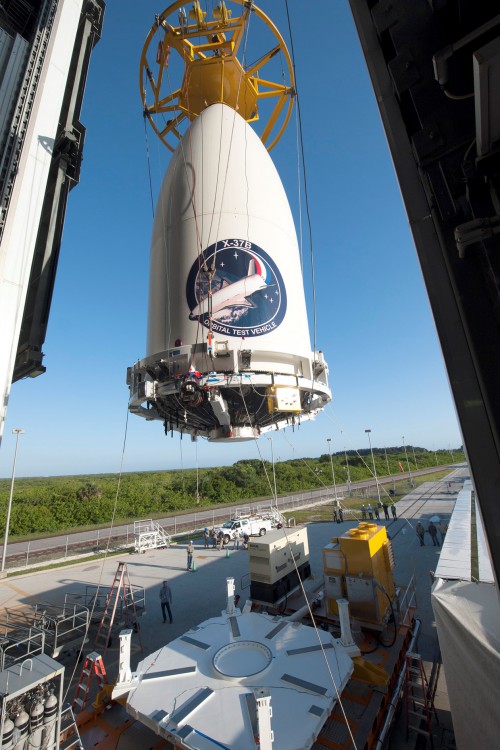
The Air Force’s secretive X-37B, the AFSPC-5 primary payload known as the Orbital Test Vehicle (OTV), will fly at least two publicly disclosed experiments onboard: a NASA materials science investigation and a military electric propulsion test. The spacecraft itself looks uncannily similar to NASA’s retired space shuttle, albeit a quarter of the size, but its true capabilities and primary mission(s) have always been classified, as is its whereabouts on orbit and mission duration.
Described as “the United States’ newest and most advanced re-entry spacecraft,” the OTV’s close resemblance to the space shuttle is misleading. In orbit, it deploys an array of gallium arsenide solar cells, which, when combined with power from a set of lithium-ion batteries, have thus far enabled it to remain aloft for more than 30 times longer than the average shuttle mission. Its payload bay measures 7 feet long and 4 feet wide and can house cargoes weighing between 500-660 pounds. An advanced avionics suite and airframe, together with electromechanical actuators and autonomous guidance controls, has focused the OTV’s mandate onto “risk reduction, experimentation, and operational concept development for reusable vehicle technologies in support of long-term developmental space objectives.”
The Planetary Society’s solar sail satellite Lightsail, which is funded entirely by private citizens, will be hitching a ride to orbit on AFSPC-5 as well, as part of a secondary payload dubbed ULTRASat. Lightsail will conduct its first flight test via AFSPC-5, giving its team an opportunity to check the operation of vital systems in the extreme environment of space in low-Earth orbit (LEO). A mission-ready Lightsail is expected launch to Medium Earth Orbit (MEO) atop a SpaceX Falcon Heavy rocket in 2016.
“I’m naturally happy and excited, but I admit, a bit nervous,” said Planetary Society CEO Bill Nye. “We’ve been working to get a solar sail into space since I joined The Planetary Society Board in 1997. It’s quite a milestone. Deep breath, no turning back now, this baby’s on its own now.”
The fully integrated Atlas-V and AFSPC-5 will be rolled out for launch May 19, with the first launch attempt scheduled to lift-off at 10:45 a.m. EDT May 20.
BELOW: The Air Force’s AFSPC-5 payload, encapsulated inside a 5-meter diameter payload fairing, is mated to an Atlas V booster inside the Vertical Integration Facility (VIF) at Cape Canaveral Air Force Station’s Space Launch Complex-41. All Photos Credit: ULA
Be sure to “Like” AmericaSpace on Facebook and follow us on Twitter: @AmericaSpace
Missions » Air Force OTV » AFSPC-5 »




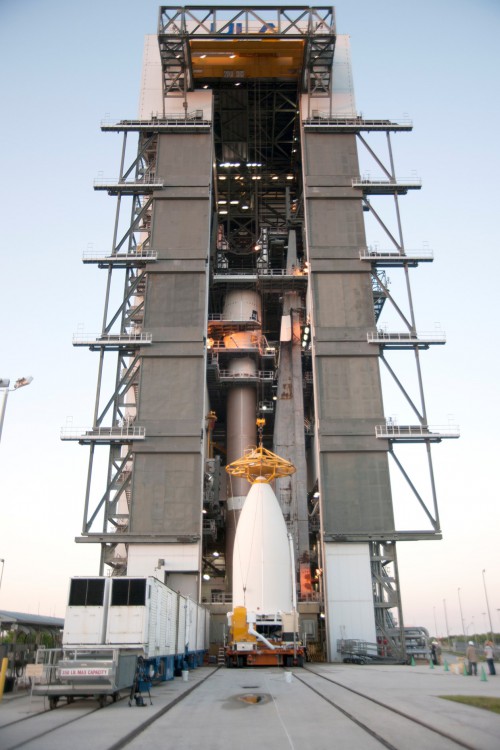
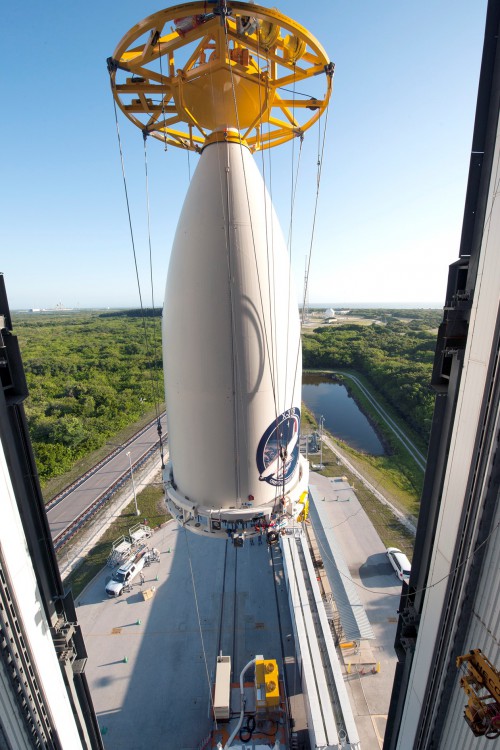
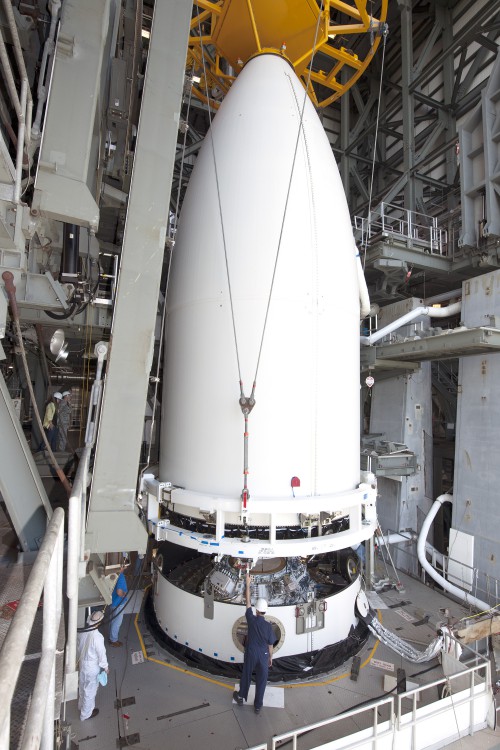
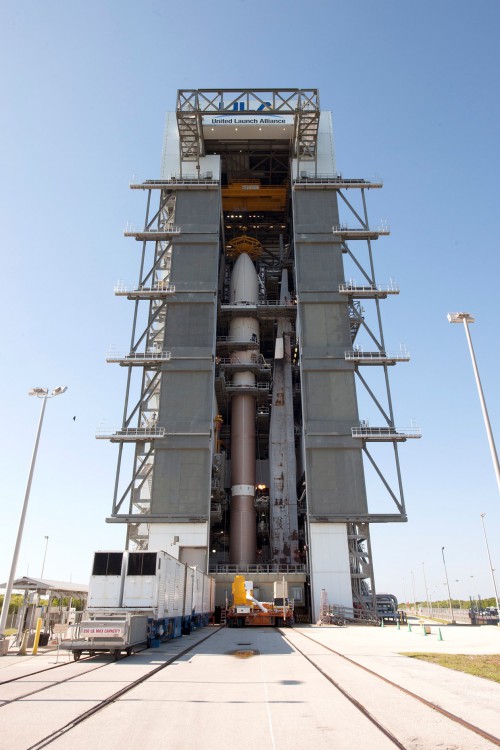
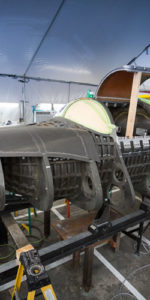
“A mission-ready Lightsail is expected launch to Medium Earth Orbit (MEO) atop a SpaceX Falcon Heavy rocket in 2016.”
NewSpace baloney.
Whoever “expects” that to happen is going to be disappointed. Whatever “mission” a lightsail is expected to perform with the couple ounces of payload it can carry, it will take years to build up enough speed to go anywhere.
The lighsail is not completely useless though as the basic concept can be used in nuclear pulse propulsion, as proposed by Solem:
http://www.fas.org/sgp/othergov/doe/lanl/docs1/00189777.pdf
The ONLY method to date that is practical for interplanetary travel and the ONLY method foreseeable for decades to come is nuclear pulse propulsion, or, “bomb propulsion.” This inconvenient truth is almost never mentioned when spaceflight is being discussed due to all the other inconvenient truths that go with it and are directly contrary to the NewSpace dogma that has hijacked public opinion.
A pulse propulsion “engine” can come in two forms, “soft” and “hard”, and perhaps some hybrid of the two as a third option. The soft form is a giant parachute or “spinnaker” sail that has serious limitations in durability and the size of bombs that can be used. The hard from is the multi-thousand ton disc a couple hundred feet across that can very efficiently utilize specially designed star wars directed energy H-bombs with an Isp in the tens of thousands.
The ONLY other interplanetary propulsion system that could possibly work is the fission-fragment-engine and this depends on Americium 242, aka unobtainium. It would take a whole new nuclear industry built from scratch to make this miracle fuel available.
“A mission-ready Lightsail is expected launch to Medium Earth Orbit (MEO) atop a SpaceX Falcon Heavy rocket in 2016.”
Going to have to agree with Gary on this one “A mission-ready Lightsail” is going to launch on a Falcon Heavy in less than a year, when a Falcon Heavy has yet to make a public appearance?
OK.
I will not directly reply to any of your posts or mention you by name on this website ever again, even if agreeing with you.
That way no misunderstandings.
Whatever, jeez
Light sail is bit of a BS cover story.
What you can do is task the like os an X-37 vehicle to place this huge metallic-mylar in front of an enemy satellite, that will block it’s view and it’s communication temporarily in time of war/skirmishes.
You can easily hide this shield all fold up somewhat close to GEO graveyard orbit, and sneak up in front of the enemy sat when needed, and disappear again into the dark quickly and not cause any property damage…and say “What treaty violation?”
I would say you are paranoid but then why is this thing going up with a classified air force payload? You could be on to something. Or maybe not. Might be just good P.R. with the science guy involved. It has always been interesting to me that the space shuttle was rumored to have so many features contrary to logic because the military wanted to kidnap a Russian spy satellite with it- and considering it’s huge never full cargo bay cross range single orbit capabilities it is just crazy enough to be true. I tend to believe it.
Could be just an overly imaginative mind. 😀 But an electric propulsion system would be the perfect engine to do this kind of work, wouldn’t it? The materials used for such system would also need to survive in space hiding behind or close to the other satellites for 10-20 years or even longer moving from one GEO slot to another, that would require long term exposure testing.
…and it so happens there are “two publicly disclosed experiments onboard: a NASA materials science investigation and a military electric propulsion test.” 😀
My take on space warfare is pretty simple M: the first move by anyone looking to take down the United States in a real war will start with launching a dozen or so vehicles carrying several tons of tungsten pellets into the various orbits- circling in the opposite direction. This would kill everything up there- a satellite apocalypse. Whenever anyone suggests this I have noticed the other participants in the discussion treat it like it would be almost as bad as dropping nuclear weapons. I disagree. It would be the smart move because those who think nobody would dare do it (us) will be disoriented and confused and take some very hard shots by way of such a surprise attack. Those who believe nobody would dare because it would be sure to trigger a nuclear war don’t understand that those launches would not be identified as ICBM and everyone would see exactly what was happening- until the satellites all died in a wave of failures. Then the war would start and it would not necessarily be a nuclear war.
The Japanese Pearl Harbored us because they thought they would do a replay of their previous war with another supposed superpower- Russia. Their goal was to kick our ass so bad we sued for peace and this would allow them to take over all of Asia and the Pacific and create a Pan-Asian empire. I am no sinophobe but if China at some time in the future decides the U.S. doing to them what we did to Japan (cut off their oil and iron and froze their assets) means war then a satellite apocalypse would be their best first move. But historically China only cares about China and unlike Japan, China has resources and I have no idea what chain of circumstance would put us at odds with them in this 21st century- but after 911 I believe anything is possible.
I mentioned the remedy for such a devastating Pearl Harbor attack on our space assets on another thread:
For those who think LEO is such a fantastic place to make money with all those non-GEO satellites think again; high altitude airships are “poised” to replace almost all of them. Hydrogen filled dirigibles hovering above 100,000 feet have, if I recall, about 500 miles of coverage out to the horizon which makes them the ultimate cell phone tower/earth observation platform. With solar cells and clear weather at that altitude they can stay up for months in most latitudes- and then come down for maintenance and go back up again. In fact, with enough of them in the air as relay stations you don’t even need GEO satellites.
How is that for a disruptive technology? Who would have thought- Zeppelins.